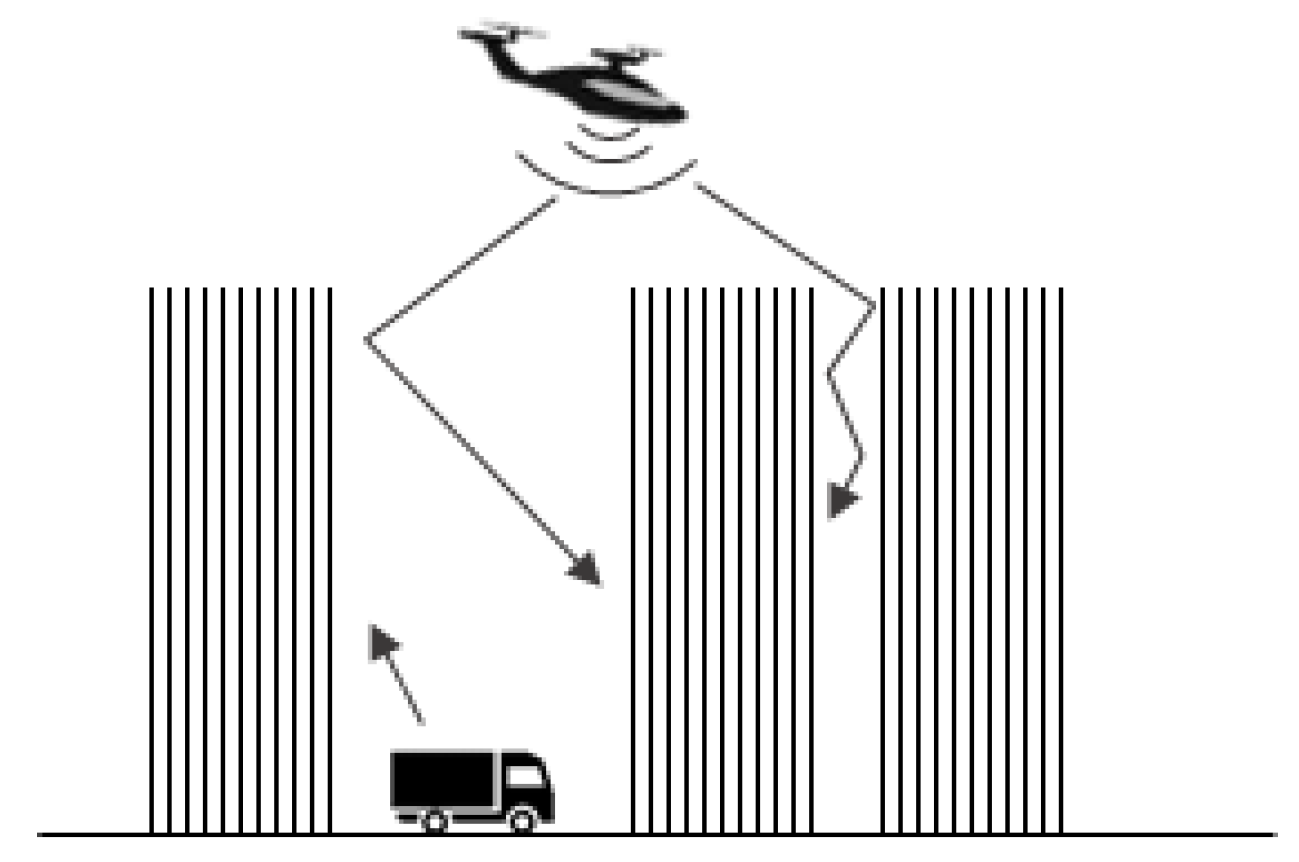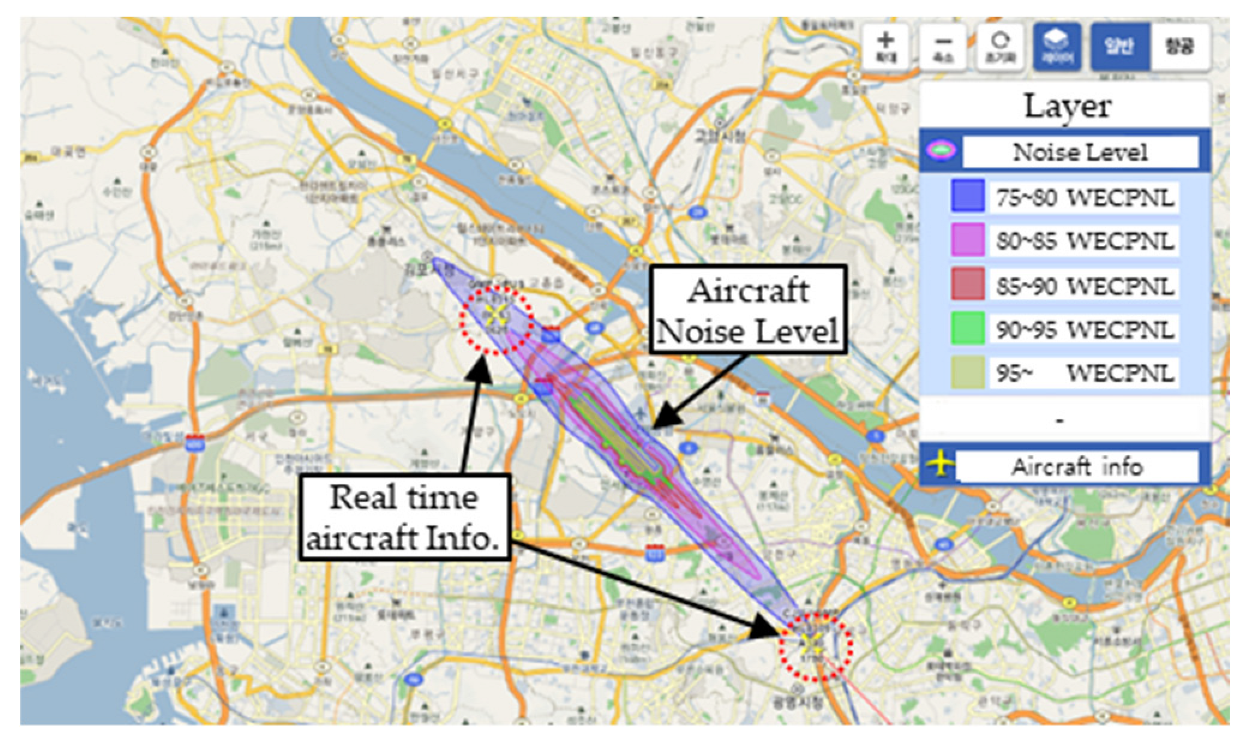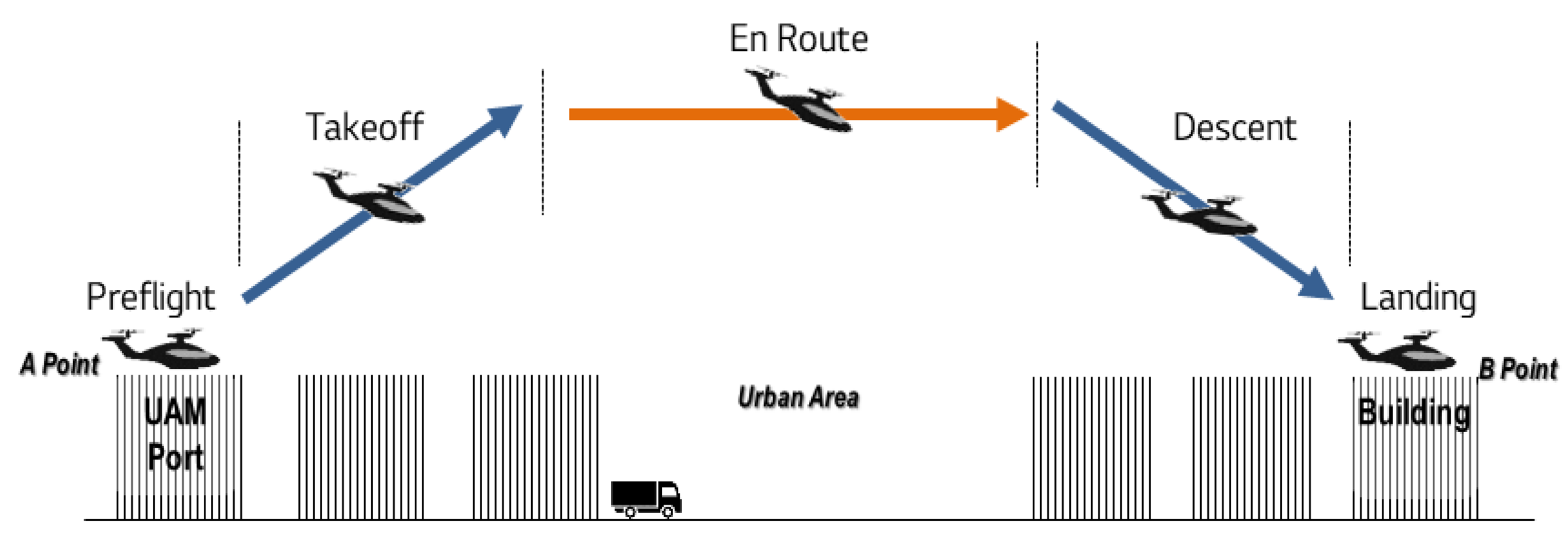The noise standards of UAM currently being proposed have nearly followed the existing noise standards of commercial aircrafts. Currently, standards for commercial aircrafts focus on noise during take-off and landing, not at operating altitude. However, UAM vehicles will fly in the upper spaces of residential buildings. This raises the question of whether current UAM noise standards are appropriate. To address this, two key questions were formulated and addressed. Specifically,
Section 3.1. Question 1 (Related to Spaces) and
Section 3.2. Question 2 (Related to Noise Affecting Urban Residents) are as follows.
3.1. Question 1 (Related to Spaces)
(1) As commercial aircrafts fly on a fixed air route, noise is limited to the vicinity of the air route. (2) However, UAM vehicles fly at low altitudes in urban areas and are likely to have constantly changing air routes. (3) Therefore, would UAM vehicles not have a lower and wider impact on city residents than commercial aircrafts?
(1) Referring to
Section 2.2. Civiel Airplane, Helicopter, and UAM Classification and Noise Level, aircraft noise standards mainly consider the take-off and landing phases. An assessment of the noise levels according to real-time aircraft movements in the Korea airport noise portal system indicates that the aircraft generates noise in the range of 85–90 dB during take-off and landing (
Table 4). In particular, in the take-off phase, the generated noise is in the range of 75–90 dB over a distance of 5 km from the runway; however, the effect on urban residents is negligible when the aircraft ascends to a certain altitude or during a cruise flight.
As the aircraft moves between Airport (District A) ↔ Airport (District B), as shown in
Table 4, the route is constant. Therefore, considering the distribution of aircraft noise according to the period, the noise pattern is practically the same; only the direction of the noise changes depending on the direction of take-off and landing. The average annual and monthly noise distribution in South Korea was in the range of 73.0–74.4 WECPNL at Gimpo Airport (113,580 flights in 2020) and 79.0–81.0 WECPNL at Jeju Airport (138,256 flights in 2020).
Table 5 summarizes the results.
(2) As discussed in
Section 2.3, take-off and landing are the main operational phases within city spaces, and the route is in the upper spaces just above the city. Meanwhile, the cruising altitude of UAM vehicles is in the range of 300 to 600 m, which is the same as the height at the time of the take-off and landing of an aircraft. This height is comparable to or lower than the height of a city building (Burj Khalifa: 828 m, Shanghai Tower: 632 m, and TAIPEI-101: 509 m). Thus, the flight height of UAM vehicles is comparable to the distance from a car in the ground space to the location of people inside the building. A simple comparison between the operations of a commercial aircraft and UAM vehicle is summarized in
Figure 1.
A UAM aircraft can take-off and land at any point; therefore, it can freely fly on these routes: Airport A (District A) ↔ Airport B (District B), Airport A (District A) ↔ UAM Port (Point A), UAM Port (Point A) ↔ Specific place (Point B), and Specific place (Point B) ↔ Airport B (District B). Additionally, the route of each district and point will be different depending on the weather, wind, and aircraft conditions. Thus, predicting the flight path of the UAM aircraft will be a challenge.
(3) First, UAM vehicles fly at an altitude that is much lower than the flight path height of a commercial aircraft, as shown in
Figure 1. This height is comparable to the height of buildings in the city. Second, the fluctuation range of the flight path is larger than that of commercial aircraft. Aircrafts fly on set routes; however, UAM vehicles change and move on various routes in real time. Therefore, the range of noise damage caused by UAM vehicles is lower than that of commercial aircrafts and will be applied more extensively.
3.2. Question 2 (Related to Noise Affecting Urban Residents)
(1) Urban residents will be exposed to both the noise generated by existing vehicles in the ground and UAM vehicles in the air. (2) In particular, UAM vehicles will fly in the upper spaces of cities and outside the line of sight of urban residents. Noise from places outside the line of sight can cause discomfort and fear. (3) Therefore, should the flight of UAM vehicles not consider the sensory noise, like the conventional noise standard?
(1) Measures to reduce or block noise generated by UAM vehicles should be considered. However, noise isolation will be difficult for UAM. For example, while it is possible to reduce the noise in a specific section by installing a noise barrier around the automobile road, it is difficult to install a device to block the noise generated by UAM vehicles flying in the air shown in
Figure 2.
The noise of a car spreads from lower to upper heights [
27] and directly affects urban residents [
28]. However, UAM vehicles flying over the city will cause extensive noise damage, owing to building reflections, and direct harm onto urban residents [
29]. It is difficult to accurately present the range of noise damage patterns. Therefore, it is necessary to establish a standard for limiting noise and conduct basic research on hybrid noise between the ground and upper spaces.
(2) In addition to the noise associated with take-off and landing, aircrafts are affecting urban residents in various forms, such as loud noises during low-altitude flights [
30], mental disorders caused by continuous exposure to aircraft noise [
31], and sensory stimulation induced by aircraft noise [
32]. In particular, helicopters generate extreme noise levels by flying at low altitudes, inflicting various types of discomfort directly on urban residents [
33]. Among them, the flight characteristics of a helicopter are noteworthy in that it flies above the locations of urban residents, wherein visibility is blocked by buildings, thereby making it difficult to determine its exact location. The flight characteristics of a UAM vehicle are very similar to those of a helicopter [
34].
Among the impacts caused by a helicopter flight are sensory discomforts, which should be considered as follows: the fear generated in situations in which urban residents cannot respond, owing to the sudden appearance of a helicopter from a place outside their line of sight or that only the sound of the rotor is being heard; mental fear of uncontrollable events, such as the possibility of the helicopter falling; and fear of a large object flying nearby. Regarding the effects of industrial noise on workers, damage caused by sensory noise types, such as intermittent and continuous sounds, in addition to the effects of physical noise (dB) in the workplace, has been suggested [
35]. Thus, UAM vehicles, require more intensive research on sensory noise in addition to physical noise, thus considering the characteristics of helicopters and the damage caused by noise in industrial sites.
(3) To understand sensory and physical noises, it is necessary to understand sound. Noise is a type of sound wave. Sound is composed of three elements: loudness, pitch, and timbre. Sound types and their characteristics are outlined in
Table 5.
The currently proposed noise standard for UAM is to use the index of EPNdB, which is a combination of loudness (dB) and pitch (Hz). UAM noise standards account for and regulate loudness and pitch. Meanwhile, there are no regulation standards for sensory properties related to timbre.
Table 6 summarizes the elements required to be defined for all stages of UAM.
The definition of the time period during which the UAM vehicle can fly, time limit for the UAM vehicle to fly in place, and time limit rotor rotation before UAM flight should be considered to establish clear standards. Furthermore, among the types of timbre, continuous, interrupted, impulsive, background, fluctuating, and intermittent noise should be considered in detail (
Table 7).
Table 8 summarizes the items necessary to expand the noise standard for each flight stage of UAM considering the continuous, interrupted, impulsive, background, fluctuating, and intermittent noise of timbre.
Noise is a subjective characteristic. Therefore, it is impossible to predict or reduce noise damage for all urban residents under the same basis. However, considering the characteristics of UAM vehicles that will fly directly above urban residents, it is clear that noise standards should be strengthened. In addition to the conventional physical noise standards, the materialization of the sensory noise standards is expected to lead to a system that resolves a significant part of the insensitivity to UAM in the city, as well as the development of UAM technologies.











